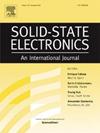CMOS back-end-of-line integration of bilayer ferroelectric tunnel junction in 1-transistor-1-capacitor circuit
IF 1.4
4区 物理与天体物理
Q3 ENGINEERING, ELECTRICAL & ELECTRONIC
引用次数: 0
Abstract
Ferroelectric tunnel junction (FTJ) devices based on ferroelectric Hf0.5Zr0.5O2 (HZO) have recently gained significant interest as CMOS back-end-of-line integrable low power non-volatile memories for neuromorphic computing applications. In this paper, we demonstrate integration of metal-ferroelectric-dielectric-metal bilayer FTJ devices in the back-end-of-line of a 180 nm CMOS technology chip. We present electrical characteristics of the integrated FTJ devices, including the polarization switching and resistance switching behavior with an ON/OFF current ratio of ∼ 18, and an ON current density of ∼ 24.5 μA/cm2 at a read voltage of 1.8 V. Furthermore, we also demonstrate a 1-transistor-1-capacitor (1T1C) circuit by connecting a back-end FTJ device with a front-end nMOS transistor, which amplifies the ON current of the FTJ device by 2.6 times. Thus, we show the basic building block for the integration of HZO-based FTJ devices for neuromorphic applications.
一晶体管一电容电路中双层铁电隧道结的CMOS后端集成
基于铁电f0.5 zr0.5 o2 (HZO)的铁电隧道结(FTJ)器件作为用于神经形态计算应用的CMOS后端可积低功耗非易失性存储器,最近引起了人们的极大兴趣。在本文中,我们展示了金属-铁电-介电-金属双层FTJ器件在180nm CMOS技术芯片后端的集成。我们介绍了集成的FTJ器件的电气特性,包括在开/关电流比为~ 18时的极化开关和电阻开关行为,以及在读取电压为1.8 V时的导通电流密度为~ 24.5 μA/cm2。此外,我们还演示了一个1-晶体管-1-电容器(1T1C)电路,通过将后端FTJ器件与前端nMOS晶体管连接,将FTJ器件的ON电流放大2.6倍。因此,我们展示了用于神经形态应用的基于hzo的FTJ器件集成的基本构建块。
本文章由计算机程序翻译,如有差异,请以英文原文为准。
求助全文
约1分钟内获得全文
求助全文
来源期刊

Solid-state Electronics
物理-工程:电子与电气
CiteScore
3.00
自引率
5.90%
发文量
212
审稿时长
3 months
期刊介绍:
It is the aim of this journal to bring together in one publication outstanding papers reporting new and original work in the following areas: (1) applications of solid-state physics and technology to electronics and optoelectronics, including theory and device design; (2) optical, electrical, morphological characterization techniques and parameter extraction of devices; (3) fabrication of semiconductor devices, and also device-related materials growth, measurement and evaluation; (4) the physics and modeling of submicron and nanoscale microelectronic and optoelectronic devices, including processing, measurement, and performance evaluation; (5) applications of numerical methods to the modeling and simulation of solid-state devices and processes; and (6) nanoscale electronic and optoelectronic devices, photovoltaics, sensors, and MEMS based on semiconductor and alternative electronic materials; (7) synthesis and electrooptical properties of materials for novel devices.
 求助内容:
求助内容: 应助结果提醒方式:
应助结果提醒方式:


